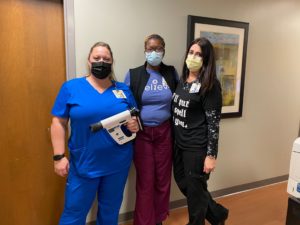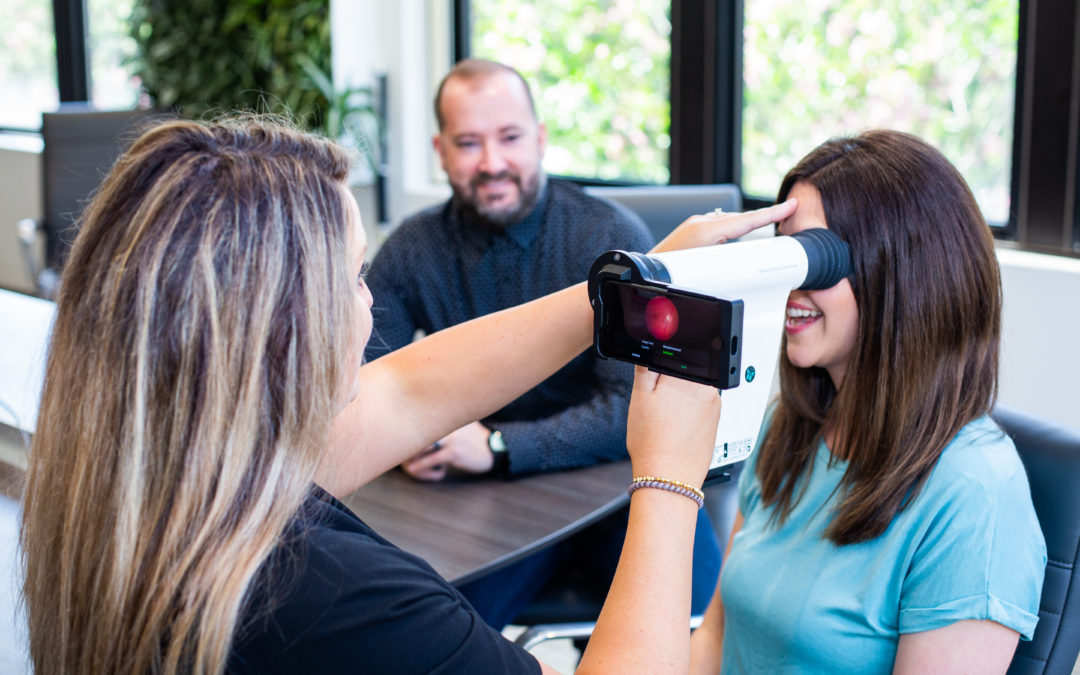Diabetes is the most common cause of preventable blindness in people ages 25-65 in the United States. Diabetic eye disease is a group of eye problems that can affect people with diabetes and includes glaucoma and cataracts, but the most common cause of blindness in those with diabetes is diabetic retinopathy. In fact, over 60% of people with diabetes will get a diagnosis of diabetic retinopathy.
What is diabetic retinopathy?
So what is it? Let’s break it down: “retino” refers to the retina, a thin layer of tissue lining the back of the inside of the eye near the optic nerve (where vision begins), and “pathy” means disease.
Over time, if blood sugar is not managed, diabetes damages small blood vessels throughout the body, including the retina. Diabetic retinopathy occurs when these tiny blood vessels become blocked and leak fluid. The subsequent swelling results in cloudy or blurred vision.
How is diabetic retinopathy identified?
The condition is progressive and often asymptomatic; those who are in the early stages may not even realize it. And although it is irreversible once it begins, diabetic blindness is preventable. That’s why the American Academy of Ophthalmology recommends that all patients with diabetes or pre-diabetes have a retinal eye exam once a year.
 Retina specialists offer advanced therapies to prevent further vision loss in those impacted, but without regular screenings, the condition can advance significantly before it is identified. Early detection of diabetic retinopathy reduces the risk of severe vision loss by 90% and regular screenings are key in identifying who is at-risk.
Retina specialists offer advanced therapies to prevent further vision loss in those impacted, but without regular screenings, the condition can advance significantly before it is identified. Early detection of diabetic retinopathy reduces the risk of severe vision loss by 90% and regular screenings are key in identifying who is at-risk.
Historically, though, only 40-50% of diabetic patients get this important screening. But, a new technology offered by Erlanger Primary Care providers aims to change that!
“We’re excited that new options for teleretinal screening, like the IRIS, allow more of the at-risk diabetic population to be conveniently screened at their regular check-ups,” says Dr. Andrew Smith at Erlanger Primary Care – Bledsoe. “This tool helps us bring appropriate and necessary healthcare to the patients that are already in our office and it has the potential to alert us to the early signs of eye disease and, ultimately, to save their eyesight.”
Can diabetic retinopathy be prevented?
The greatest contributors to reducing the development of advanced stages of the disease are blood sugar management and screening. But, regardless of how well a patient manages their blood sugar, retinal exams are recommended for everyone living with diabetes. Anyone with diabetes including type 1, type 2, gestational, and even pre-diabetes can develop diabetic retinopathy.
“The better a patient manages their blood sugar, the less risk there is. But the longer a patient has diabetes, the more likely it is to occur,” says Ronald L. Gross, MD. Dr. Gross is a board-certified ophthalmologist whose study of telemedicine in the prevention of blindness within the diabetic population at West Virginia University found that with technology like IRIS, or Intelligent Retinal Imaging Systems, in partnership with primary care providers is crucial to reducing preventable blindness.
“There are 4 states of progression and the earlier we can identify the signs, the better. Fortunately for patients, a quick and non-invasive eye exam can quickly provide annual screenings to help identify when specialized care is needed before it’s too late.” Erlanger primary care providers can now capture, enhance, and diagnose diabetic retinopathy within two business days.
Staying up-to-date with all screenings is crucial when it comes to managing diabetes. If it’s time for your check-up or to be screened for diabetic retinopathy, make an appointment with your primary care provider today. If you don’t have one, find one here and ask about the options for retinal screenings including IRIS.







